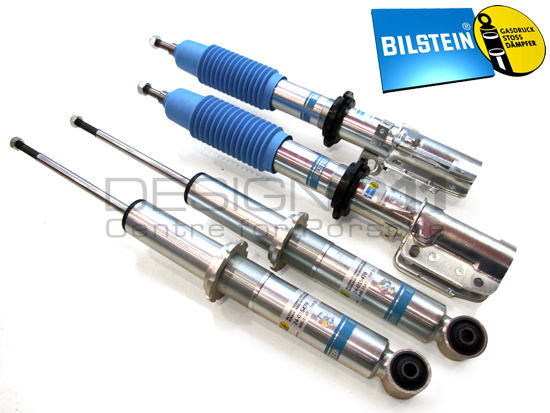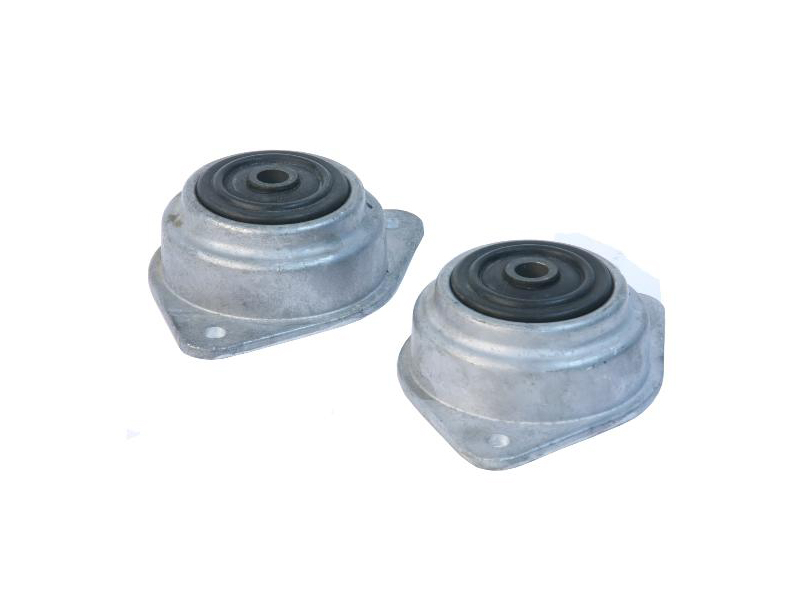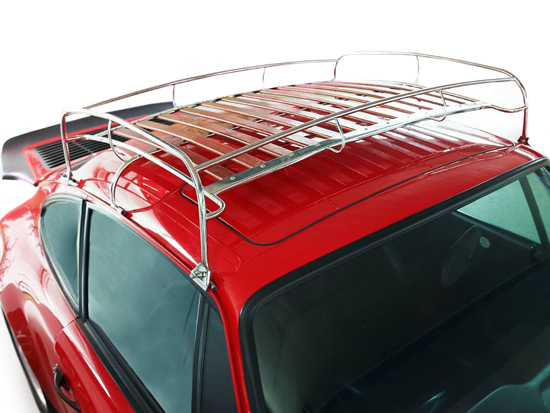
The History Of The 964
Introduction
In 1989 Porsche introduced the new generation of the 911 Carrera model. The 964 Model came along the market about the same time when phasing out of the G series occurred.
Although it retained the classic shape of the G series, the 964 had much better aerodynamics than the G model. It contained 85% of new parts and exciting new features, some of which were revolutionary for its time. The all-wheel-drive system would electronically control wheel slippage and automatically transfer power according to the relevant driving situation. The driver could always maintain a great degree of control.
The first 964’s that arrived were equipped with all-wheel drive and were commonly known as the Carrera 4. Later, in 1990 a rear-wheel drive version named Carrera 2 was added to the range. Both versions were available in the Coupé, Targa, and Cabriolet body designs.
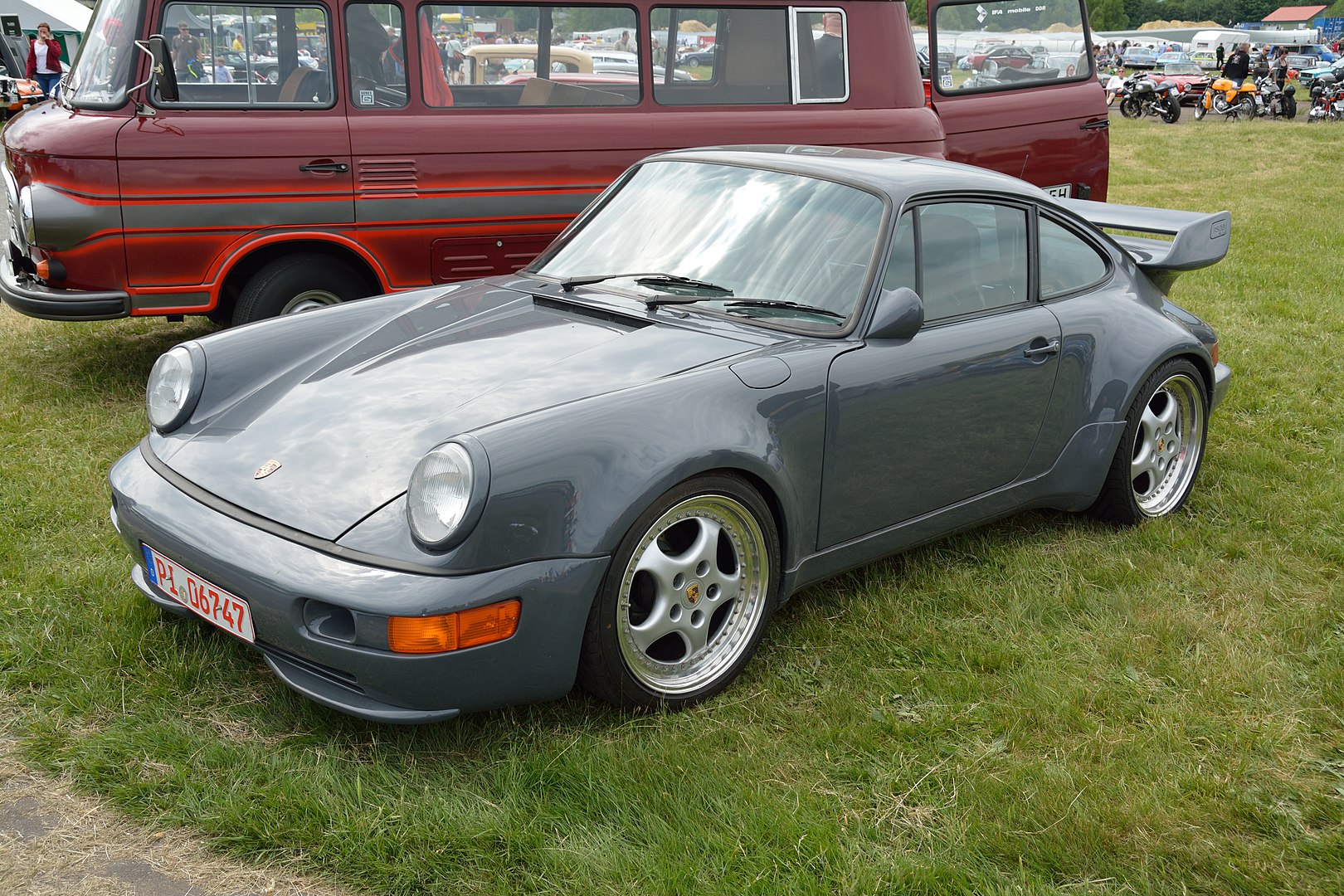
By –Nightflyer (talk) 21:35, 29 May 2016 (UTC) – Own work, CC BY 4.0, https://commons.wikimedia.org/w/index.php?curid=49100864
Design and Specifications
Engine and mechanics
The new 911 included many of the features that have been lacking in previous versions. The chassis was completely redesigned with rear suspension switching from a torsion bar to trailing arms with a “Weissach” rear axle, which enabled self-steering elements to reduce the chance of oversteering.
It featured a naturally aspirated 3.6-litre engine called M64 that produced an impressive 250 horsepower on both Carrera 2 and 4 versions.
Interior and Exterior
The modern design of the interior was almost completely reimagined to blend performance with comfort. The ‘heavy’ airbag steering wheel was initially optional and then became standard and the automatic climate control system was vastly improved. A variety of warning lights were included in the revised instrument panel that was connected to the car’s central system. The driver would be informed about a possible problem or malfunction instantly.
Alongside the new and improved inner workings, the exterior was also upgraded. To improve aerodynamics, the bumpers and fog lights were integrated into the body, and an electronic rear spoiler was added that automatically raised at speeds over 50 mph. Other notable upgrades included ABS, Tiptronic automatic transmission, power steering, standard dual airbags, and twin-spark ignition.
The 964 Carrera was the last generation that was sold with the traditional Targa roof until 2011.
Models and variations
Apart from the standard Carrera 4 and Carrera 2, Porsche produced several other variations of the 964 series. The most significant are Speedster, RS, and Turbo.
Speedster
Presented at the 1988 Frankfurt Motor Show next to the upcoming Carrera 4, the 1989 Speedster was more similar to the 930 Turbo than the upcoming 964 generations. Due to this, it was considered to be a much inferior car to the later 1994 Speedster. Only 800 of these models were built between 1989 and 1993 and most of them included the wide-body option (641 of them).
The 1994 Porsche 911 Speedster was introduced based on Carrera 2 platform and was available either in standard or lightweight trim called “club sport.”. It was designed to be a more focused “driver’s car” and intended to be a hybrid between a 964 Carrera 2 Cabriolet and a 964 RS. Although it featured a softer suspension setup than the 964 RS, it had almost none of the comforts of a normal 964 Carrera 2 Cabriolet.
Porsche initially planned production of 3000 Speedsters, but only 936 were actually built and sold during the two years period. Although it was not initially available, there were 20 models finished at Porsche Exclusive Werk 1 with the wide-body option.
As a special order from the Hong Kong businessman Kevin Yeung, Porsche built Sonderwunsh (“Special Wishes”) Speedster. This car was lightweight, superior to other versions in many aspects, and finished in slate grey colour – the same as Steve McQueens model from the movie Le Mans. It was the very last 964 Speedster that was ever produced. It was built by hand at Werk 1 together with the 964 America GS 3.8 Hardtop Roadster commissioned by a New Yorker.
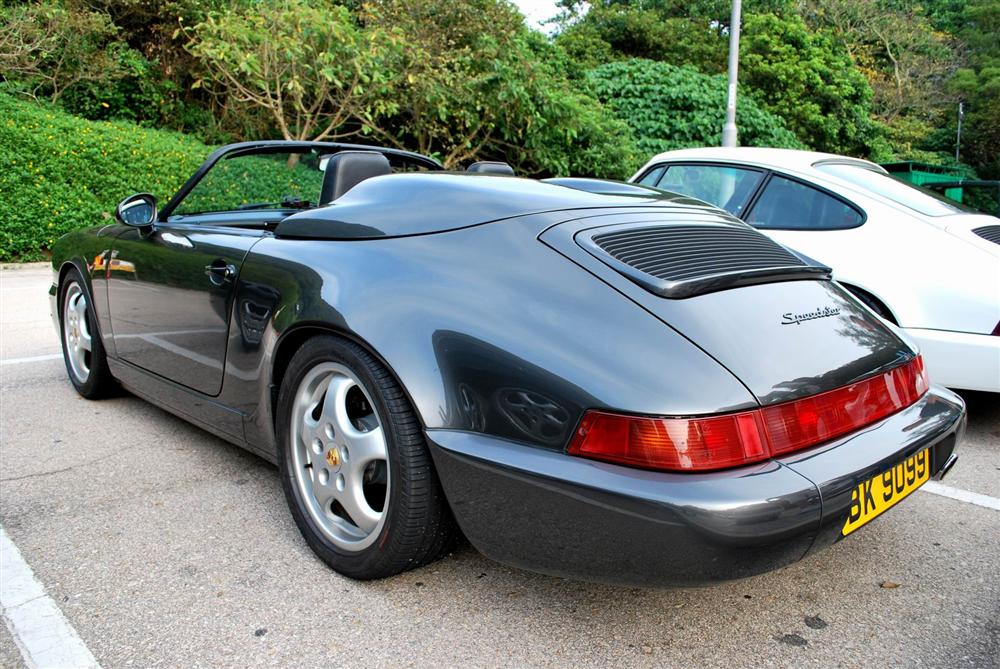
CC0, https://commons.wikimedia.org/w/index.php?curid=113227661
RS
The RS versions of Model 964 were introduced in 1992. A super-lightweight, rear-wheel-drive, Carrera RS was intended for the European market. It was based on the Carrera Cup race car, and it featured a revised version of the standard engine, with an increased power output of 260 and various other enhancements suited for a race car. The Interior was completely removed from all the comforts and all that was left were new racing-bucket front seats, a blank metal interior, and a roll cage.
A heavier Touring variant was also available with sound deadening, power seats (optional), undercarriage protection, and power windows. They came with optional lights on the visors. To satisfy the American appetite, Porsche released the Model Carrera RS America in 1993. Based on the Carrera 2, the RS America was a stripped-out, lightweight version that featured a whale tail spoiler and a luggage shelf instead of a back seat.
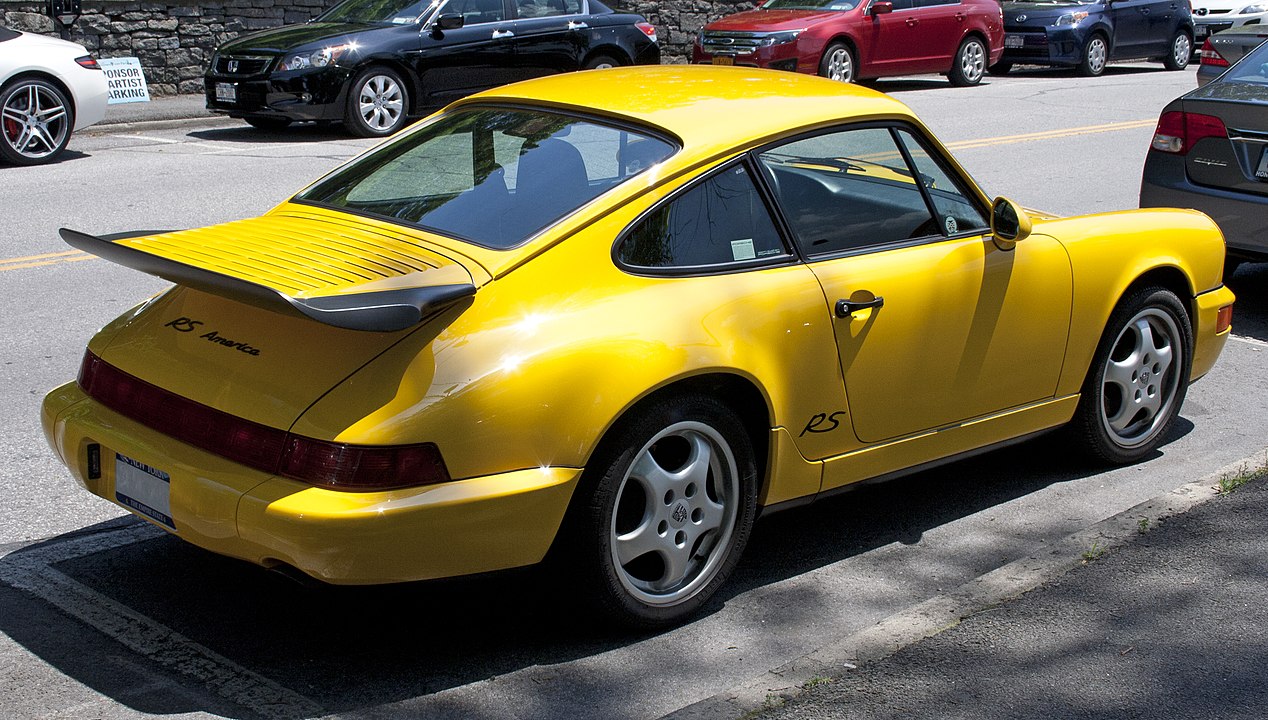
By Mr.choppers – Own work, CC BY-SA 3.0, https://commons.wikimedia.org/w/index.php?curid=20292639
Turbo
The Turbo version of the Model 964 was released in March of 1990. Since they hadn’t had the necessary time to develop a turbocharged version of the 3.6-litre M64 engine, Porsche re-used the 3.3L engine from the Type 930 with some minor revisions and adjustments which allowed for increased power of 320hp and reduced turbo lag.
In 1993 they finally made the 3.6L M64 turbo. This advanced and fine-tuned version of the M64 engine produced an impressive 360hp at 5,500 rpm and 384 lb-ft at 4,200 rpm of torque. It was produced only for the model year 1993/1994, with fewer than 1,500 of them produced in total, making it one of the rarest and most sought-after Porsches since 959.
An extremely limited version of this model was created at the end of production in 1994. The 90 Turbo chassis that remained were transferred to Porsche Exclusive and turned into model Turbo 3.6S. It was available with the traditional Turbo body or with the flachbau ‘slant nose’ option – which was even more exclusive.

By Abehn – Own work, Public Domain, https://commons.wikimedia.org/w/index.php?curid=889141
Legacy
To commemorate 30 years since they launched the 911, Porsche introduced the 30th Anniversary C4 in 1993. It had the normally aspirated engine and standard small lifting wing and was based on the wider turbo body with 4-wheel drive. This version was the start of a line that continued with the 993 C4S and 996 C4S.
The final production numbers for the Model 964 with all its variations totalled 62,172. The production of Model 964 was stopped in 1994 to make way for the next model in the line, the Porsche 911 Model 993 – the last of the air-cooled 911s.
Selected Porsche 964 Upgrades
Black Diamond CROSS DRILLED & GROOVED Performance Brake Discs FRONT
Black Diamond Combi Discs are engineered and made using Computer Aided Design (CAD) and manufacturing to ensure they are finished to the most exacting standards.
The Black Diamond Combi discs feature 12 curved radial grooves on each disc face with machined holes in between each groove for excellent heat dissipation and cooling. This combination of machined surfaces also helps to de-glaze the pads, offering greater friction under hard braking conditions and making them less likely to fade. The result is a better pedal feel and improved brake response.
The unique compound and heat treatment after machining combine to provide awesome braking performance that will improve stopping power and give longer-lasting durability.
You can shop it here.
Bilstein Sports B6 FRONT and REAR shock absorbers PACKAGE
Bilstein Sports B6 FRONT and REAR shock absorbers PACKAGE Porsche 964 Early CarsThe shock absorbers are for those drivers who prefer a sports suspension but are not particularly interested in lowering the body. Also available in special design complete with a reservoir for off-road vehicles.
No risk, more fun
For some people, it’s important to show what they have, for others it’s sufficient to know that they have it. The theme of the discussion here is sports suspension. The BILSTEIN B6 Sports shock absorber is the ideal solution for drivers revelling in the understatement. The wolf in sheep’s clothing snarls, when necessary, but otherwise goes reliably about its work in daily traffic with no lowering of the body whatsoever.
Optimum road holding enhanced tracking stabilisation and excellent damping force: the BILSTEIN B6 Sports is not only the first choice as far as sports tuning is concerned but also in the sphere of safety.
You can shop it here.
Brembo Sport brake pads
Tested to the highest levels on the track with decelerations from 270kph (168mph) the HP2000 material is capable of operating in the most demanding conditions.
With excellent cold performance & bite, high resistance to fade, frictional stability throughout all operating conditions, reduced pad & disc wear and low dust levels, the all-new HP2000 friction material offer significant advantages over its rivals.
Designed to be a direct replacement for the Original Equipment (OE) pads the Brembo sport pad comes with the same specification as the OE pad including (where applicable): fitted wear leads, slots for separate wear leads and anti-rattle clips with the added benefit of anti-noise shims on every pad.
Combine all of this with competitive pricing and UNECE R90 approval across the full range (making them street legal) and you get a true high-performance brake pad fit for the road.
Sold as a set of 4 pads for one axle.
You can shop it here.
Engine Mount Kit – HD RS version
Engine Mount Kit. HD RS version.
Replaces factory hydraulic mounts. 1 kit with 2 mounts, hardware not included. This set can be used as an upgrade for standard 964/993
You can shop it here.
Seats in RennSport RS Style, Black-Grey
Seats in RennSport RS Style, Black-Grey. Porsche 964 / 993
(price is for 2 seats)
You can shop it here.
Luggage roof rack with classic wooden slates
Luggage roof rack with classic wooden slates
Material: Stainless Steel & Teak Wood
You can shop it here.

